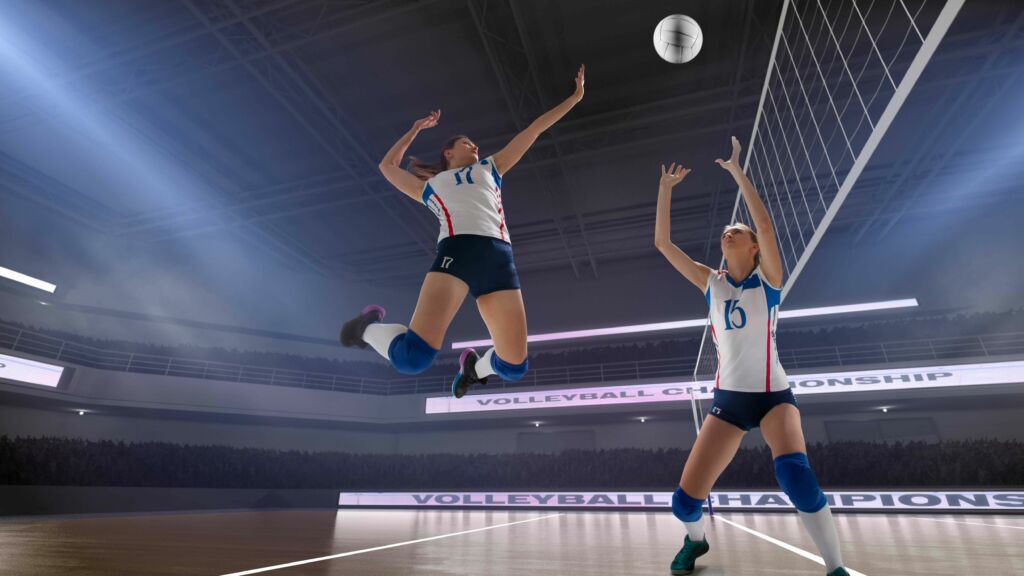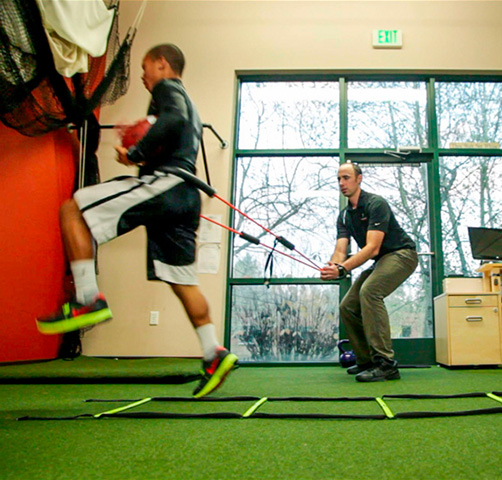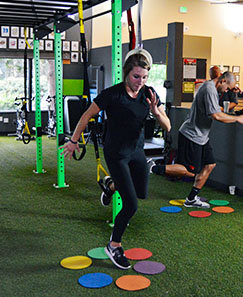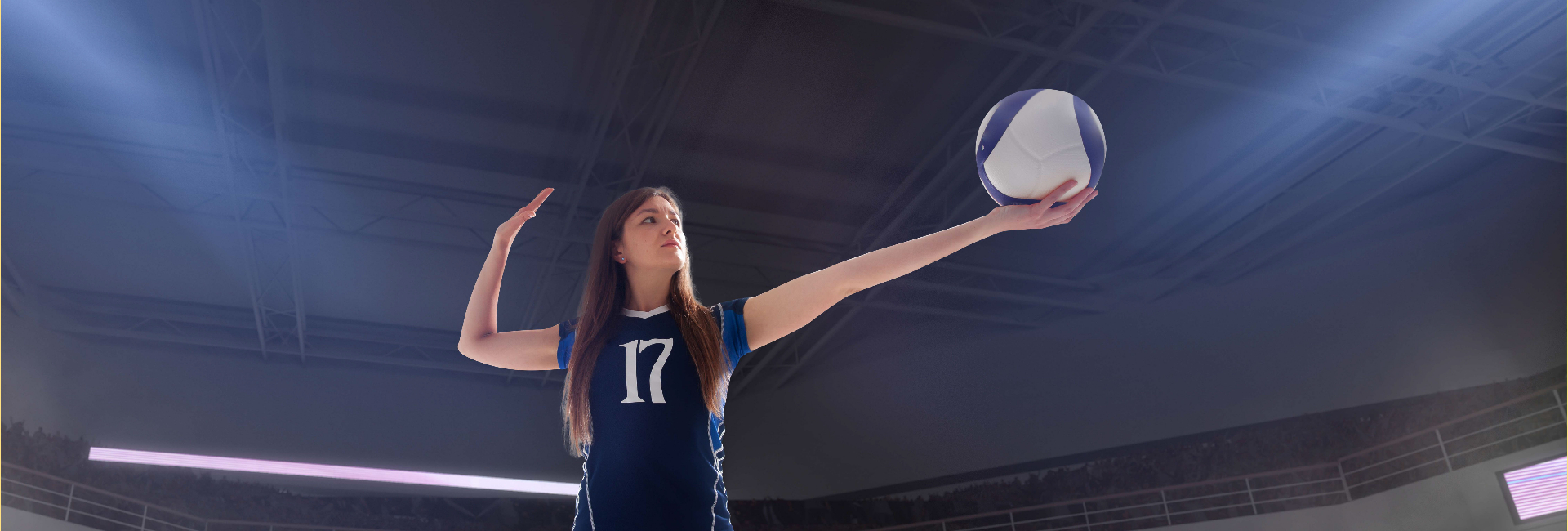Volleyball. The fast-paced team sport where the goal is to get the ball over a really tall net and make it hit the floor on the other team’s side all while screaming “mine,” jumping, sprinting, diving, blocking, passing, setting and spiking or hitting. Who wouldn’t want to play this exciting, high-speed sport? With summer break behind us, volleyball season is ramping up for middle school and high school athletes. Depending on the level of pre-season conditioning you or your young athlete has done over the summer, the last thing you want is to go full speed ahead and potentially cause an injury early in the season.
If you or someone you know has ever been injured while playing a sport, you know that it can be mentally and physically difficult to put training on hold in order to properly recover. But what if you could prevent the majority of sports injuries from happening, or decrease the time it takes to bounce back?
Going into the season knowing that injuries happen in sports, but also having a plan of attack to prevent and address injuries if they do occur, is important.
TOP 4 INJURIES IN VOLLEYBALL
- Ankle Injuries
Injuries related to the ankle joint are the most common for acute injury in volleyball athletes.1 Most ankle sprains happen while at the net when players are jumping to block or spike and then land on another player’s foot. Rolling the ankle in an unexpected and quick way to stretch the ligaments and/or tendons on the side of the ankle joint. These ligaments and tendons provide stability, and without stability it’s very hard to hard to have the necessary power for jumping. Having sustained a previous ankle sprain in the past can increase the risk of re-injuring the ankle.1
WHAT TO DO
If you or a teammate sustains an ankle injury and walking is difficult, it is advised to get assessed by your school’s athletic trainer, your local physical therapist, or another healthcare provider as soon as possible. These professionals will be able to assess the joint and rule out a fracture. Once a fracture is ruled out, active rest is generally the most appropriate plan to start rehabbing back to pre-injury condition. Performing as much pain-free movement as possible is key.
- Knee Injuries
Volleyball athletes can experience two different types of knee injuries. One being an overuse injury commonly known as “jumper’s knee,” and clinically known as patellar tendinopathy. This type of knee pain can depend on training volume, spike approach and jumping mechanics, and gender assigned at birth.1,2 With repetitive jumping throughout multiple practices and competitions per week, there is excess stress through the quadriceps muscles and the patellar tendon.

The second most common type of knee injury is an acute ligament injury. Knee ligament injuries usually occur from quick change of direction or landing from a jump improperly.1,3 The anterior cruciate ligament (ACL) is the ligament that is most commonly injured due to the potential forces generated at the knee joint with landing tasks.3
WHAT TO DO
If you suspect that your knee pain could be related to jumper’s knee, then addressing it sooner rather than later is best to get back to playing without pain. Unloading of the patellar tendon for 2-4 weeks can be necessary. This could mean activity modification with jumping and weight training as well as use of bracing or taping. After a period of relative rest, the tendon is reloaded with eccentric and other exercises. An example exercise could be a heels-elevated single leg squat with emphasis on slow lowering, then using the other limb to return to a standing position. Three sets of 10 repetitions, once daily.2
If you notice pain and swelling after suddenly tweaking your knee, then it’s recommended that you get assessed by the athletic trainer or local physical therapist to determine the extent of the injury and if additional intervention is needed.
- Shoulder Injuries
Because the majority of offensive plays happen with overhead tasks such as spiking, tipping, serving, and blocking, the shoulder can be a common but unfortunate place to have an injury. Shoulder injuries tend to be related to overuse or repetitive stress.1 Similar to patellar tendinopathy (see above), shoulder injuries depend on volume of training, form with overhead tasks, and position (front row player vs. back row). Subacromial impingement syndrome and rotator cuff tendinopathies are common shoulder overuse injuries.1,4
WHAT TO DO
Resting the shoulder from overhead activity for a couple weeks and performing pain-free tasks and exercises is a good place to start. Have your coach or a physical therapist take a closer look at your form to see if there are ways to unload some stress from the shoulder.
- Low Back Injuries
Low back injuries are less common than the ones listed above, but it’s important to note that they can happen from overuse as well. During a spike approach or jump serve, there is a considerable amount of hyperextension and rotational torque that the trunk is doing.1,4
When volleyball players get into this “cocked” position repetitively, it can begin to put excessive loads on the joints in the spine, which then causes irritation and pain.4
WHAT TO DO
If you’re experiencing back pain while playing, consider slowing down on the hitting practice and cooling it on the jump serves for a couple weeks. Additionally, incorporate isometric trunk stability exercises such as elbow planks, side planks, and bird dog.
Injury Prevention Strategies for Youth Volleyball
- Warm-up and Cool-down
Utilize a dynamic warm-up before practices and games and incorporate cool-down stretches after practices and games.5 Performing sport-specific movements without resistance and at reduced speed can also be a good way to prevent injury before playing.
- Neuromuscular Training
Incorporating neuromuscular training programs such as strengthening of joint stabilizing muscles, trunk stability, and plyometrics, as well as proprioceptive tasks such as dynamic balance with landing and eyes closed balance training have been shown to be effective in reducing injury in jumping sports.5 Neuromuscular training and stability exercises for the rotator cuff and other shoulder blade muscles are also important to incorporate for preventing shoulder injuries.4
- Eccentric Loading
Consider adding more eccentric loading into the resistance training regimen for improving strength, power, mobility and reducing risk of injury.2 An example of eccentric loading would be if someone were doing bicep curls with a dumbbell, the eccentric part of the exercise would be the slow and controlled lowering of the dumbbell.
- Ankle Support
Use of ankle braces may be an effective option for prevention of ankle sprains.5
- Soft Landings
Landing mechanics are important! It’s recommended to land on two feet rather than a single leg. Also, increasing the amount of hip flexion and knee flexion upon contact with the ground is associated with decreased risk of ACL injury.3 In other words, don’t land with a stiff leg, and absorb your land by bending your knees and hips.
When should I seek help with a volleyball injury?
If you, a teammate, or your young athlete has experienced an injury and the pain doesn’t seem to be improving with active rest, taping/bracing and/or other pain reduction strategies, then it is time to get an evaluation from a physical therapist. A physical therapist will be able to assess what might be causing the pain, educate on recovery timeline, develop a home exercises program appropriate for the stage of healing, and refer out to another medical provider if necessary.
References
- REITMAYER H-E. A review on volleyball injuries. Timisoara Physical Education & Rehabilitation Journal. 2017;10(19):189-194. Accessed September 12, 2022. https://search.ebscohost.com/login.aspx?direct=true&db=s3h&AN=137140075&site=eds-live
- Kulig K, Noceti-DeWit LM, Reischl SF, Landel RF. Physical therapists’ role in prevention and management of patellar tendinopathy injuries in youth, collegiate, and middle-aged indoor volleyball athletes. Braz J Phys Ther. 2015 Sep-Oct;19(5):410-20. doi: 10.1590/bjpt-rbf.2014.0126. Epub 2015 Oct 6. PMID: 26537811; PMCID: PMC4647152.
- Xu D, Jiang X, Cen X, Baker JS, Gu Y. Single-Leg Landings Following a Volleyball Spike May Increase the Risk of Anterior Cruciate Ligament Injury More Than Landing on Both-Legs. Applied Sciences. 2021; 11(1):130. https://doi.org/10.3390/app11010130
- Seminati E, Minetti AE. Overuse in volleyball training/practice: A review on shoulder and spine-related injuries. European Journal of Sport Science. 2013;13(6):732-743. Accessed September 12, 2022. https://search.ebscohost.com/login.aspx?direct=true&db=s3h&AN=92039033&site=ehost-live
- Veigel, Jake D.1; Pleacher, Michael D.2. Injury Prevention in Youth Sports. Current Sports Medicine Reports: November 2008 – Volume 7 – Issue 6 – p 348-352 doi: 10.1249/JSR.0b013e31818f06e7
Additional Resources
Experts in Sports Injury Recovery
We are committed to providing effective, efficient, and compassionate care to help you return to pain-free sport. Our passion is to help every patient reach their goals on their journey to recovery and optimal performance.



